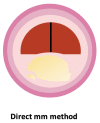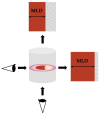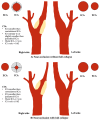Quantifying Carotid Stenosis: History, Current Applications, Limitations, and Potential: How Imaging Is Changing the Scenario
- PMID: 38255688
- PMCID: PMC10821425
- DOI: 10.3390/life14010073
Quantifying Carotid Stenosis: History, Current Applications, Limitations, and Potential: How Imaging Is Changing the Scenario
Abstract
Carotid artery stenosis is a major cause of morbidity and mortality. The journey to understanding carotid disease has developed over time and radiology has a pivotal role in diagnosis, risk stratification and therapeutic management. This paper reviews the history of diagnostic imaging in carotid disease, its evolution towards its current applications in the clinical and research fields, and the potential of new technologies to aid clinicians in identifying the disease and tailoring medical and surgical treatment.
Keywords: CTA; DSA; MRA; artificial intelligence; carotid disease; carotid endarterectomy; carotid stenosis; near-occlusion; plaque-RADS; vulnerable carotid plaque.
Conflict of interest statement
The authors declare no conflicts of interest.
Figures






Similar articles
-
Carotid Plaque Vulnerability Diagnosis by CTA versus MRA: A Systematic Review.Diagnostics (Basel). 2023 Feb 9;13(4):646. doi: 10.3390/diagnostics13040646. Diagnostics (Basel). 2023. PMID: 36832133 Free PMC article. Review.
-
Contemporary carotid imaging: from degree of stenosis to plaque vulnerability.J Neurosurg. 2016 Jan;124(1):27-42. doi: 10.3171/2015.1.JNS142452. Epub 2015 Jul 31. J Neurosurg. 2016. PMID: 26230478 Review.
-
Grading of carotid artery stenosis in the presence of extensive calcifications: dual-energy CT angiography in comparison with contrast-enhanced MR angiography.Clin Neuroradiol. 2015 Mar;25(1):33-40. doi: 10.1007/s00062-013-0276-0. Epub 2013 Dec 17. Clin Neuroradiol. 2015. PMID: 24343701 Clinical Trial.
-
Evaluating non-invasive medical imaging for diagnosis of carotid artery stenosis with ischemic cerebrovascular disease.Chin Med J (Engl). 2003 Jan;116(1):112-5. Chin Med J (Engl). 2003. PMID: 12667401
-
Three-dimensional computed tomography angiography and magnetic resonance angiography of carotid bifurcation stenosis.Eur Neurol. 2001;46(1):25-34. doi: 10.1159/000050752. Eur Neurol. 2001. PMID: 11455180 Clinical Trial.
Cited by
-
Silent brain ischemia within the TAXINOMISIS framework: association with clinical and advanced ultrasound metrics.Front Neurol. 2024 Oct 11;15:1424362. doi: 10.3389/fneur.2024.1424362. eCollection 2024. Front Neurol. 2024. PMID: 39474371 Free PMC article.
-
A comprehensive scoping review of existing carotid duplex ultrasound scanning and reporting protocols: identifying gaps and opportunities for standardization of practice in low-income countries.J Ultrasound. 2025 Aug 28. doi: 10.1007/s40477-025-01064-1. Online ahead of print. J Ultrasound. 2025. PMID: 40866737 Review.
References
-
- Hippocrates. Adams F. The Genuine Works of Hippocrates. William Wood & Co.; New York, NY, USA: 1886.
Publication types
LinkOut - more resources
Full Text Sources

